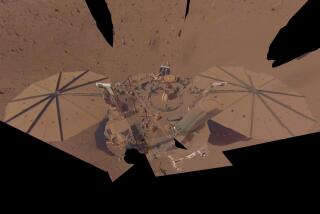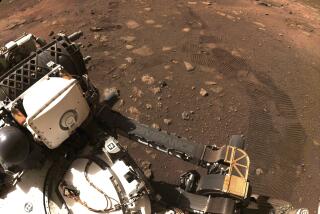A Salty Sea Long Ago Lapped on Surface of Mars, NASA Discovers
Portions of the Martian surface were once covered with an ancient salty sea, NASA scientists said Tuesday, announcing a discovery that transforms the image of the now-frigid and desolate planet.
Evidence of the body of water, possibly covering hundreds or thousands of square miles, was found near the landing site of the rover Opportunity in Meridiani Planum near the Martian equator. The rover has been exploring the planet since Jan. 24.
“The rocks at Meridiani were not only modified by water, they were actually formed in water,” said Ed Weiler, NASA associate administrator for space science, at a news conference in Washington. “This is a profound discovery. It has profound implications for astrobiology.
NASA scientists announced earlier this month that they had determined that water had once existed on Mars, possibly during the early history of the planet 3 billion to 4 billion years ago. But they did not know if the water was percolating in underground reservoirs or actually flowed on the surface in lakes, rivers or seas.
They have now determined that the rocks at Meridiani Planum were formed in a standing body of water, long since evaporated from the desiccated landscape of towering canyons and rock-strewn craters.
Although the water may have been shallow, it was more probably “water you can swim in,” and perhaps very deep, said Steve Squyres, a Cornell University geologist who serves as the mission’s chief scientist.
The finding is the strongest evidence yet that Mars once had a habitable environment.
Matt Golombek, a mission geologist at the Jet Propulsion Laboratory in Pasadena, said the standing water means that portions of the Martian environment were once much warmer than today’s frozen desert. The planet’s atmosphere is likely to have been much denser, or the water would have evaporated rapidly, he said.
NASA gathered the new data about two weeks ago, then had the results reviewed by outside experts, all of whom concurred with the agency’s conclusions.
“I was astonished to see structures like we see on Earth,” said Dave Rubin, a geologist with the U.S. Geological Survey and one of the independent reviewers.
He compared the terrain to the salt-encrusted Qaidam Basin in central China. Other scientists said it resembled Death Valley, itself an ancient sea bed.
The scientists realized that to unravel the mystery of Mars’ ancient surface they would need to examine the texture of surface rocks in minute detail. Only the most detailed images could let them discern the fine differences in sediment layering caused by air compared to those of flowing water.
The striations on rocks formed by wind-blown sediments are relatively flat and uniform. Those formed by water currents tend to be irregular -- divergent and jutting patterns caused by the lapping flows of water against sediment.
Scientists at JPL directed Opportunity to capture 152 high-resolution images of a small, layered rock called Last Chance, a promising part of a bedrock outcropping near the landing site.
They then created an ultra-detailed mosaic of those images for close examination.
What they found erased all doubts that water flows shaped the rocks. Scientists discovered fine cross-hatched textures in the layered rocks called “festooning” and “crossbedding” -- classic signs of water-formed rocks.
In festooning, tiny smile-shaped curves are produced when currents of water shift sediments beneath the surface, causing small wave-like crests. Crossbedding creates layers of sedimentary rock at divergent angles, said John Grotzinger, a rover scientist from the Massachusetts Institute of Technology.
The overall pattern suggests a body of water at least two inches deep, moving about 1 mph, Grotzinger said.
Water percolating below the surface, occasionally emerging and receding, could not have formed the irregular patterns, Squyres said.
Scientists don’t know the extent of the Martian sea. It could have been substantial -- perhaps covering most of the Meridiani Planum, Golombek said.
They are also uncertain if other bodies of water existed on the planet. But Golombek said that it is likely that flowing water existed elsewhere since the odds against Opportunity landing at the only sea on Mars were astronomical.
Other scientists cautioned that such sweeping conclusions could be premature.
Bruce C. Murray, professor of planetary science at Caltech and a former director of JPL, said that the presence of jarosite, an iron-bearing mineral, at the Meridiani Planum site suggests high acidity, more like underground water than a large lake or sea.
He added that the flat terrain of the site did not appear to indicate a lake or sea basin.
Regardless, Murray still applauded Opportunity’s research, saying that whatever the form of Mars’ water, the rover’s findings still confirmed that the planet was capable of nurturing life.
At the news conference NASA scientists acknowledged that there is still much more work to do. The farther Opportunity travels over the next weeks or months, the more precisely scientists should be able to map the remnants of ancient surface water.
The prospect of vast seas or oceans on Mars boosted the possibility of determining whether life once existed on the planet.
“This is a step in the direction of the answer -- a pretty important step,” said Roger Launius, a space historian at the Smithsonian Institution.
The most conclusive evidence would be to actually find some fossil remains in the rocks scattered across the landscape.
The rocks being examined are “exceptionally good for preserving [fossil] evidence of microbial life,” Squyres said.
But the rovers’ instruments lack the sensitivity to detect microscopic fossils.
“I don’t expect to find microbial fossils and I certainly don’t expect to find dinosaur tracks,” Squyres said with a laugh.
Mars is certain to hold on to many mysteries for future missions, such as how much of the planet was covered with water, and why that water disappeared.
Scientists eventually hope to trace the evolution of the Martian atmosphere, a thin gauze that most experts believe was largely lost eons ago to unknown planetary forces.
Opportunity and Spirit, located on the other side of the planet in Gusev Crater, are scouting out sites for NASA’s plan to return to Mars in 2009 with a mobile lab that would be equipped to identify fossils.






